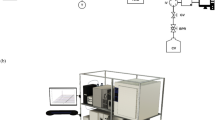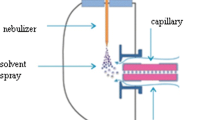Abstract
How to determine multipesticide residues in vegetables is important for the modern society. The development of a simple, rapid, and sensitive method to determine pesticide residues is significant. Our study used common vegetables—leaf lettuce and cucumber, and a new molecularly imprinted polymer (MIP) was synthesized using O,O′-dimethylthiophosphoryl chloride, an intermediate for the manufacture of organophosphorus pesticides, as the template, methacrylic acid as the functional monomer, and ethylene glycol dimethacrylate as the cross-linker. The adsorption capacities of the prepared MIP toward five organophosphorus pesticides (trichlorfon, dichlorvos, dimethoate, imidacloprid, and methamidophos) were evaluated, and its potential as a sorbent for solid-phase extraction was investigated. A novel method for the simultaneous determination of multiple organophosphorus pesticide residues in vegetables was developed by utilizing molecularly imprinted solid-phase extraction (MISPE) coupled with gas chromatography. Under optimal solid-phase extraction conditions, with a flow rate of 3.0 mL/min for loading 100 mL, the enrichment factor was in the range of 36–452 for the five organophosphorus pesticides. The peak area precision of the five organophosphorus pesticides based on five replicates was from 1.59 to 4.07%. The leaf lettuce spiked sample was used to verify the fortified recovery for this method, and the results ranged from 87.48 to 97.85%. The MISPE–gas chromatography method could be used to detect organophosphorus pesticide residues in lettuce leaf and cucumber from the farmer’s market, and the detection limit had no obvious difference from the national standards. This method can meet the requirements of the analysis of pesticides in complex matrix.





Similar content being viewed by others
References
Armenta S, de la Guardia M, Abad-Fuentes A, Abad-Somovilla A, Esteve-Turrillas FA (2015) Off-line coupling of multidimensional immunoaffinity chromatography and ion mobility spectrometry: a promising partnership. J Chromatogr A 1426:110–117
Brust H, Willemse S, Zeng T, van Asten A, Koeberg M, van der Heijden A et al (2014) Impurity profiling of trinitrotoluene using vacuum-outlet gas chromatography-mass spectrometry. J Chromatogr A 1374:224–230
Cao S, Liu L, Lu Q, Xu Y, Pan S, Wang K (2009) Integrated effects of ascorbic acid, flavonoids and sugars on thermal degradation of anthocyanins in blood orange juice. Eur Food Res Technol 228:975–983
Chatterjee NS, Utture S, Banerjee K, Shabeer TPA, Kamble N, Mathew S, Kumar KA (2016) Multiresidue analysis of multiclass pesticides and polyaromatic hydrocarbons in fatty fish by gas chromatography tandem mass spectrometry and evaluation of matrix effect. Food Chem 196:1–8
Chen Q, Fung Y (2010) Capillary electrophoresis with immobilized quantum dot fluorescence detection for rapid determination of organophosphorus pesticides in vegetables. Electrophoresis 31:3107–3114
Chen LG, Li B (2012) Determination of imidacloprid in rice by molecularly imprinted-matrix solid-phase dispersion with liquid chromatography tandem mass spectrometry. Journal of Chromatography B-Analytical Technologies in the Biomedical and Life Sciences 897:32–36
Chen J, Duan C, Guan Y (2010) Sorptive extraction techniques in sample preparation for organophosphorus pesticides in complex matrices. Journal of Chromatography B-Analytical Technologies in the Biomedical and Life Sciences 878:1216–1225
Farajzadeh MA, Mogaddam MRA, Nabil AAA (2015) Polyol-enhanced dispersive liquid-liquid microextraction coupled with gas chromatography and nitrogen phosphorous detection for the determination of organophosphorus pesticides from aqueous samples, fruit juices, and vegetables. J Sep Sci 38:4086–4094
Farid MM, Goudini L, Piri F, Zamani A, Saadati F (2016) Molecular imprinting method for fabricating novel glucose sensor: polyvinyl acetate electrode reinforced by MnO2/CuO loaded on graphene oxide nanoparticles. Food Chem 194:61–67
Guo T, Deng QL, Fang GZ, Liu CC, Huang X, Wang S (2015) Molecularly imprinted upconversion nanoparticles for highly selective and sensitive sensing of cytochrome c. Biosens Bioelectron 74:498–503
Hamdan S, Moore L Jr, Lejeune J, Hasan F, Tk C, Bara JE et al (2016) Ionic liquid crosslinkers for chiral imprinted nanoGUMBOS. J Colloid Interf Sci 463:29–36
Jenkins AL, Yin R, Jensen JL (2001) Molecularly imprinted polymer sensors for pesticide and insecticide detection in water. Analyst 126:798–802
John H, Eddleston M, Clutton RE, Worek F, Thiermann H (2010) Simultaneous quantification of the organophosphorus pesticides dimethoate and omethoate in porcine plasma and urine by LC-ESI-MS/MS and flow-injection-ESI-MS/MS. Journal of Chromatography B-Analytical Technologies in the Biomedical and Life Sciences 878:1234–1245
Li W, Sun Y, Yang CC, Yan XM, Guo H, Fu GQ (2015) Fabrication of surface protein-imprinted nanoparticles using a metal chelating monomer via aqueous precipitation polymerization. Acs Appl Mater Inter 7:27188–27196
Lin L, Chen H, Wei HB, Wang F, Lin JM (2011) On-chip sample pretreatment using a porous polymer monolithic column for solid-phase microextraction and chemiluminescence determination of catechins in green tea. Analyst 136:4260–4267
Liu Y, Tang Y, Song J, Hu Z (2014) Determination of four organophosphorus pesticides and their metabolites in vegetables using solid-phase extraction coupled with liquid chromatography tandem mass spectrometry. Se pu = Chinese journal of chromatography 32:139–144
Liu YX, Liu L, He YH, He QH, Ma H (2016) Quantum-dots-encoded-microbeads based molecularly imprinted polymer. Biosens Bioelectron 77:886–893
Mohamed R, Mottier P, Treguier L, Richoz-Payot J, Yilmaz E, Tabet J-C, Guy PA (2008) Use of molecularly imprinted solid-phase extraction sorbent for the determination of four 5-nitroimidazoles and three of their metabolites from egg-based samples before tandem LC-ESIMS/MS analysis. J Agric Food Chem 56:3500–3508
Pirsaheb M, Fattahi N, Shamsipur M (2013) Determination of organophosphorous pesticides in summer crops using ultrasound-assisted solvent extraction followed by dispersive liquid-liquid microextraction based on the solidification of floating organic drop. Food Control 34:378–385
Qi DW, Fei T, Sha YF, Wang LJ, Li G, Wu D, Liu BZ (2014) A novel fully automated on-line coupled liquid chromatography-gas chromatography technique used for the determination of organochlorine pesticide residues in tobacco and tobacco products. J Chromatogr A 1374:273–277
Satunkhe VP, Sawant IS, Banerjee K, Wadkar PN, Sawant SD (2015) Enhanced dissipation of triazole and multiclass pesticide residues on grapes after foliar application of grapevine-associated Bacillus species. J Agric Food Chem 63:10736–10746
Savant RH, Banerjee K, Utture SC, Patil SH, Dasgupta S, Ghaste MS, Adsule PG (2010) Multiresidue analysis of 50 pesticides in grape, pomegranate, and mango by gas chromatography-ion trap mass spectrometry. J Agric Food Chem 58:1447–1454
Shen X, Su Q, Zhu X, Gao Y (2007) Determination of pesticide residues in soil by modified matrix solid-phase dispersion and gas chromatography. Ann Chim 97:647–653
Su R, Xu X, Wang X, Li D, Li X, Zhang H, Yu A (2011) Determination of organophosphorus pesticides in peanut oil by dispersive solid phase extraction gas chromatography-mass spectrometry. Journal of Chromatography B-Analytical Technologies in the Biomedical and Life Sciences 879:3423–3428
Tan J, Li R, Jiang ZT (2014) Discrimination of fresh fruit juices by a fluorescent sensor, array for carboxylic acids based on molecularly imprinted titania. Food Chem 165:35–41
Tiwari BK, O'Donnell CP, Patras A, Cullen PJ (2008) Anthocyanin and ascorbic acid degradation in sonicated strawberry juice. J Agric Food Chem 56:10071–10077
Wang Q, Zhang X, Xu Z, Gao H (2015) Simultaneous determination of three trace organophosphorus pesticide residues in vegetables using molecularly imprinted solid-phase extraction coupled with high-performance liquid chromatography. Food Anal Methods 8:2044–2051
Wen YY, Chen LX, Li JH, Ma YL, Xu SF, Zhang Z et al (2012) Molecularly imprinted matrix solid-phase dispersion coupled to micellar electrokinetic chromatography for simultaneous determination of triazines in soil, fruit, and vegetable samples. Electrophoresis 33:2454–2463. doi:10.1002/elps.201100612
Xu D, Zhu W, Wang C, Wei Z (2014) Molecularly imprinted photonic polymers as sensing elements for the creation of cross-reactive sensor arrays. Chem-Eur J 20:16620–16625
Yang YK, Fang GZ, Wang XM, Liu GY, Wang S (2016) Imprinting of molecular recognition sites combined with pi-donor-acceptor interactions using bis-aniline-crosslinked Au-CdSe/ZnS nanoparticles array on electrodes: development of electrochemiluminescence sensor for the ultrasensitive and selective detection of 2-methyl-4-chlorophenoxyacetic acid. Biosens Bioelectron 77:1134–1143
Author information
Authors and Affiliations
Corresponding author
Ethics declarations
Funding
This study was funded by “Hainan province production project (grant number CXY20140012)”, “Hainan university social service projects (grant number SHFW201605),” “Hainan province innovation research project of graduate students(Hys2016–47),” and“Hainan University graduate student outstanding paper cultivation plan.”
Conflict of Interest
Jian Chen declares that he has no conflict of interest. Wen-ting Zhang declares that she has no conflict of interest. Yang Shu declares that she has no conflict of interest. Xin-hui Ma declares that he has no conflict of interest. Xian-ying Cao declares that she has no conflict of interest.
Ethical Approval
This article does not contain any studies with human or animal subjects.
Informed Consent
Informed consent is not applicable for this study.
Rights and permissions
About this article
Cite this article
Chen, J., Zhang, Wt., Shu, Y. et al. Detection of Organophosphorus Pesticide Residues in Leaf Lettuce and Cucumber Through Molecularly Imprinted Solid-Phase Extraction Coupled to Gas Chromatography. Food Anal. Methods 10, 3452–3461 (2017). https://doi.org/10.1007/s12161-017-0875-5
Received:
Accepted:
Published:
Issue Date:
DOI: https://doi.org/10.1007/s12161-017-0875-5




